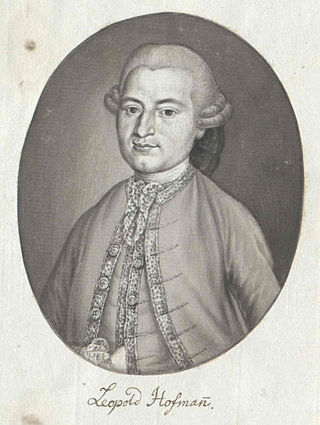Related Research Articles

Carl Philipp Stamitz was a German composer of partial Czech ancestry. He was the most prominent representative of the second generation of the Mannheim School.

Mannheim school refers to both the orchestral techniques pioneered by the court orchestra of the Elector Palatine in Mannheim in the latter half of the 18th century and the group of composers of the early classical period, who composed for the orchestra of Mannheim. The father of the school is considered to be the Bohemian composer Johann Stamitz. Besides him, two generations of composers wrote compositions for the orchestra, whose reputation was due to its excellent discipline and the individual skill of its players; the English traveler Charles Burney called it "an army of generals". Their performance style included new dynamic elements, crescendos and diminuendos. Composers of the Mannheim school played an important role in the development of the classical period's genres and of the classical symphony form.

Johann Wenzel Anton Stamitz was a Bohemian composer and violinist. His two surviving sons, Carl and Anton Stamitz, were composers of the Mannheim school, of which Johann is considered the founding father. His music is stylistically transitional between the Baroque and Classical periods.

Johann Christian Innocenz Bonaventura Cannabich, was a German violinist, composer, and Kapellmeister of the Classical era. A composer of some 200 works, he continued the legacy of Johann Stamitz and helped turn the Mannheim orchestra into what Charles Burney described as "the most complete and best disciplined in Europe.". The orchestra was particularly noted for the carefully graduated crescendos and diminuendos characteristic of the Mannheim school. Together with Stamitz and the other composers of the Mannheim court, he helped develop the orchestral texture that paved the way for the orchestral treatment of the First Viennese School.
Anton Thadäus Johann Nepomuk Stamitz was a German composer and violinist. He was born in the Holy Roman Empire.

Franz Ignaz Beck was a German violinist, composer, conductor and music teacher who spent the greater part of his life in France, where he became director of the Grand Théâtre de Bordeaux. Possibly the most talented pupil of Johann Stamitz, Beck is an important representative of the second generation of the so-called Mannheim school. His fame rests on his 24 symphonies that are among the most original and striking of the pre-Classical period. He was one of the first composers to introduce the regular use of wind instruments in slow movements and put an increasing emphasis on thematic development. His taut, dramatic style is also remarkable for its employment of bold harmonic progressions, flexible rhythms and highly independent part writing.

Leopold Hofmann was an Austrian composer of classical music.
The Orchestral Trios, Op. 1 was the first publication of a work by Jan Václav Stamic and one of the two prints issued during his lifetime. It was a famous and influential set of six orchestral trios. Most likely its composition dates from the 1750s.
The Symphony in D major, Op. 3, No. 2 is a symphony by Johann Stamitz, written in the style of the Mannheim school sometime from 1750 to 1754. The symphony was published as No. 4 in a 1769 publication of six symphonies by Stamitz. It consists of four movements:
- Presto
- Andantino
- Menuetto – Trio
- Prestissimo

Ignaz Fränzl was a German violinist, composer and representative of the second generation of the so-called Mannheim School. Mozart, who heard him at a concert in November 1777, wrote of him in a letter to his father: He may not be a sorcerer, but he is a very solid violinist indeed. Fränzl carried the Mannheim violin technique, established by Johann Stamitz, one step further to real virtuosity. Mozart, quite a good violinist himself and thoroughly acquainted with the instrument, praised Fränzl's double trill and said he had never heard a better one.
Louis-Balthazar de La Chevardière was a French music publisher in the second half of the 18th century.